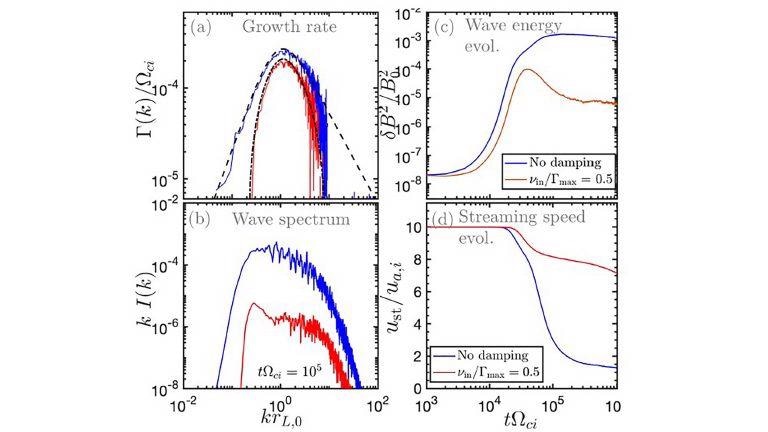Reviewed by Alex SmithAug 25 2021
Cosmic rays can be described as charged subnuclear particles traveling close to the speed of light. These particles constantly rain down on the Earth and are relativistic, as proposed by Albert Einstein’s special relativity. They manage to produce a magnetic field that regulates the way they move inside the galaxy.
 This illustration shows how waves and particles interact — wave amplitude is growing while particle drift speed is dropping due to scattering. Image Credit: A. Marcowith, A.J. van Marle, and I. Plotnikov.
This illustration shows how waves and particles interact — wave amplitude is growing while particle drift speed is dropping due to scattering. Image Credit: A. Marcowith, A.J. van Marle, and I. Plotnikov.
Gas present inside the interstellar medium is predominantly made of hydrogen and ionized atoms, implying that its protons and electrons are isolated. When cosmic rays move around inside this gas, they kickstart the background protons, causing a collective plasma wave movement similar to the ripples on a lake when a stone is tossed.
The key question is how cosmic rays transmit their momentum into the background plasma that constitutes the interstellar medium. Plasma astrophysicists from France have reviewed recent advancements in the area of study regarding the streaming instability induced by cosmic rays in astrophysical and space plasma. The findings of the study have been reported in Physics of Plasmas, from AIP Publishing.
Cosmic rays may help explain aspects of our galaxy from its smallest scales, such as protoplanetary disks and planets, to its largest scales, such as galactic winds.
Alexandre Marcowith, University of Montpellier
Up until now, cosmic rays were considered to be somewhat distinct within galaxy “ecology.” However, since instability works well and is more powerful than predicted around cosmic ray sources, like pulsars and supernova remnants, these particles possibly have far more effects on galactic dynamics and the star formation cycle than considered earlier.
“This is not really a surprise, but more of a paradigm shift,” noted Marcowith. “In science and astrophysics, everything is connected.”
Supernova shock waves that expand the interstellar/intergalactic medium “are known to accelerate cosmic rays, and because cosmic rays are streaming away, they may have contributed to generating the magnetic field seeds necessary to explain the actual magnetic field strengths we observe around us,” added Marcowith.
Once the amplitude of a plasma wave reduces or is damped over time, quite similar to those produced by a stone thrown into a lake, it heats the gas within the plasma. It also promotes cosmic ray scattering.
This occurrence needs waves with wavelengths of the same order as the cosmic ray gyro radius. Cosmic rays exhibit a helical (spiral) motion around the magnetic field, and its radius is known as the Larmor radius.
Say you are driving a car on a winding road. If the wavelength is of the same order as your wheel size, it will be difficult to drive.
Alexandre Marcowith, University of Montpellier
These waves strongly scatter cosmic rays, and the streaming instability related to the collective streaming motion of cosmic rays causes the main instability at the origin of these perturbations (waves).
There are several fields of research in astrophysics using similar numerical techniques to investigate the impact of this streaming instability within different astrophysical contexts such as supernova remnants and jets. This instability and turbulence it creates may be the source of many astrophysical phenomena, and it shows how cosmic rays play a role in the big circus of our Milky Way.
Alexandre Marcowith, University of Montpellier
Journal Reference:
Marcowith, A., et al. (2021) The cosmic ray-driven streaming instability in astrophysical and space plasmas featured. Physics of Plasmas. doi.org/10.1063/5.0013662.